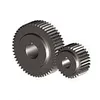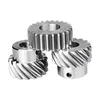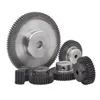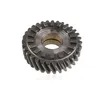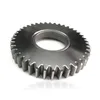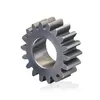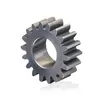A spur gear is a cylindrical toothed gear with teeth that are parallel to the axis of rotation. They are the most common type of gears used in various mechanical applications due to their simplicity, efficiency, and cost-effectiveness. Spur gears transmit motion and power between parallel shafts, offering high load capacity and reliability. These gears are widely utilized in industries such as automotive, aerospace, manufacturing, and robotics.
Our spur gears are engineered to meet the highest standards of quality and performance. They are manufactured using advanced techniques and premium materials to ensure durability, precision, and smooth operation. Below are some standout features:
Our spur gears come in a range of specifications to suit diverse needs. The parameters include module, number of teeth, pressure angle, material, and more. Refer to the table below for detailed specifications:
| Parameter | Range/Options | Description |
|---|---|---|
| Module (mm) | 0.5 to 10 | Defines the size of the teeth; larger modules handle higher loads. |
| Number of Teeth | 10 to 200 | Determines gear ratio and speed transmission. |
| Pressure Angle | 14.5°, 20°, or 25° | Affects tooth strength and smoothness of operation; 20° is most common. |
| Material | Steel, Brass, Nylon, Acetal | Steel for high strength, brass for corrosion resistance, plastics for lightweight and quiet operation. |
| Bore Diameter (mm) | 5 to 100 | Customizable to fit shaft sizes; can include keyways or set screws. |
| Face Width (mm) | 5 to 50 | Wider faces increase load capacity and durability. |
| Heat Treatment | Case hardening, Tempering | Enhances surface hardness and wear resistance for longer life. |
| Accuracy Grade | AGMA 6 to 12, ISO 5 to 10 | Higher grades offer better precision for critical applications. |
Spur gears are versatile and used in numerous applications across various sectors. Their ability to provide efficient power transmission makes them ideal for:
Choosing our spur gears ensures several benefits that enhance performance and reliability:
What is a spur gear used for?
Spur gears are primarily used to transmit motion and power between parallel shafts in various mechanical systems, such as vehicles, machinery, and appliances. They are ideal for applications requiring high load capacity and efficiency.
How do I select the right spur gear for my application?
Consider factors like load requirements, speed, material compatibility, environmental conditions, and space constraints. Our technical team can assist in choosing the appropriate module, number of teeth, and material based on your specific needs.
What materials are best for spur gears?
Steel is preferred for high-strength applications, brass offers good corrosion resistance, and plastics like nylon or acetal are used for lightweight, quiet operations. The choice depends on factors like load, noise, and environment.
Can spur gears be used in high-speed applications?
Yes, but they may produce more noise compared to helical gears. Using precision-machined gears with proper lubrication can mitigate noise and ensure smooth high-speed operation.
How do I maintain spur gears?
Regular inspection for wear, proper lubrication, and ensuring alignment can extend gear life. Avoid overloading and operate within specified limits to prevent damage.
What is the difference between spur gears and helical gears?
Spur gears have straight teeth parallel to the axis, while helical gears have angled teeth. Helical gears operate more quietly and smoothly but are more complex and costly. Spur gears are simpler and more efficient for many applications.
Are custom spur gears available?
Yes, we offer custom spur gears tailored to your specifications, including unique sizes, materials, tooth profiles, and tolerances. Contact us with your requirements for a quote.
What standards do your spur gears comply with?
Our gears meet international standards such as AGMA (American Gear Manufacturers Association) and ISO (International Organization for Standardization), ensuring quality and reliability.
